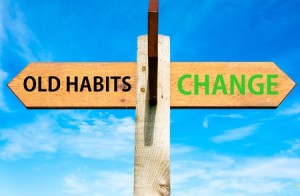Sticking to your resolutions and reaching them can be difficult. There are reasons that you set the resolution. You resolved to change. How do you attain the change?
 To live life intentionally you have to form great habits. It takes discipline and courage to make changes and to instill great habits.
To live life intentionally you have to form great habits. It takes discipline and courage to make changes and to instill great habits.
The first question to ask yourself: is the resolution you set something you really want to attain? How badly do you desire to achieve the results? To make constructive change you have to want to change. If you determine the resolution is not something you really want drop it and come up with things you are determined to change.
A habit, as defined by the Merriam-Webster Dictionary, is a usual way of behaving: something that a person does often in a regular and repeated way. It takes anywhere from 18 days to 254 days to form a habit according to a study by Phillippa Lally published in the European Journal of Psychology, October 2010.
To form great habits you have to break down activities in to steps. Then you have determine what activities you need to do on a daily, weekly and monthly basis.
Getting fit and losing weight seem to be popular resolutions. The resolution may be to join a fitness center. The goal might be to lose 15 pounds. The process would be to set up the steps and determine by what date or timeline you are going to get the activity completed.
4 Stages to Attaining a Resolution
- Plan Your Steps With Target Dates
- Set Short-Term and Long Term Goals With Target Dates
- Measure Your Progress
- Reward Yourself
For example:
Step 1: Pick out 3 fitness centers to visit. Complete by 2/1, Visit Center 1 by 2/5, Center 2 by 2/7, Center 3 by 2/9
Step 3: Join fitness center of choice by 2/11
Step 4: Meet with a personal trainer to set up a workout program centered on your weight loss goals by 2/12
Step 5: Meet with nutritionist to set up a meal plan to meet your weight loss goal by 2/15
Step 6: Set targets to attain
Step 7: Put your workout days and workout times in your calendar
Step 8: Set short term goals with your trainer and nutritionist
Step 9: Take your measurements on a scheduled basis
Step 10: Celebrate when you reach a target
One of the things that is extremely valuable in keeping your resolution and hitting your goals is to create accountability. In this example if you hired a personal trainer and set weekly meetings with your nutritionist to track your progress you have created accountability. On top of that you would be paying for each of these services so if you do not show up for the workout you still have to pay.
Some of your habits might include showing up for your workout on the scheduled date and time for 60 days. Meet weekly with your nutritionist for 60 days. Take weight and body measurements weekly. Do a fitness test on a monthly basis. Shop for your food on a weekly basis.
Just a side note, if your goal is to lose weight I am personally more in favor of body measurements and body fat measurement rather than the scale. The key is not how much you weigh, but how you look. If you like the way you look, the weight does not matter. If you do prefer to use a scale, Wednesday mornings tend to be a good day to weigh yourself.
If this is one of your resolutions the first month is going to be the hardest. If you have not worked out for a while you are going to be very sore for a few weeks. That is why the fitness centers are not as crowded in February as they were in January. Many people have great intentions, but they don’t succeed because they don’t stick it out long enough to create the habit.
Set short term goals on the way to your long term goal and reward yourself. For example, you set a long-term goal to lose 3 inches on your waistline. You have an interim goal to lose 1 inch on your waist by 2/28. You hit the goal by the target date. Celebrate and reward yourself with your favorite meal or dessert.
The first 90 days are the hardest of starting anything new. Stay the course for at least 90 days. You will be on your way to creating great habits and reaching your resolutions.
Be Great!


